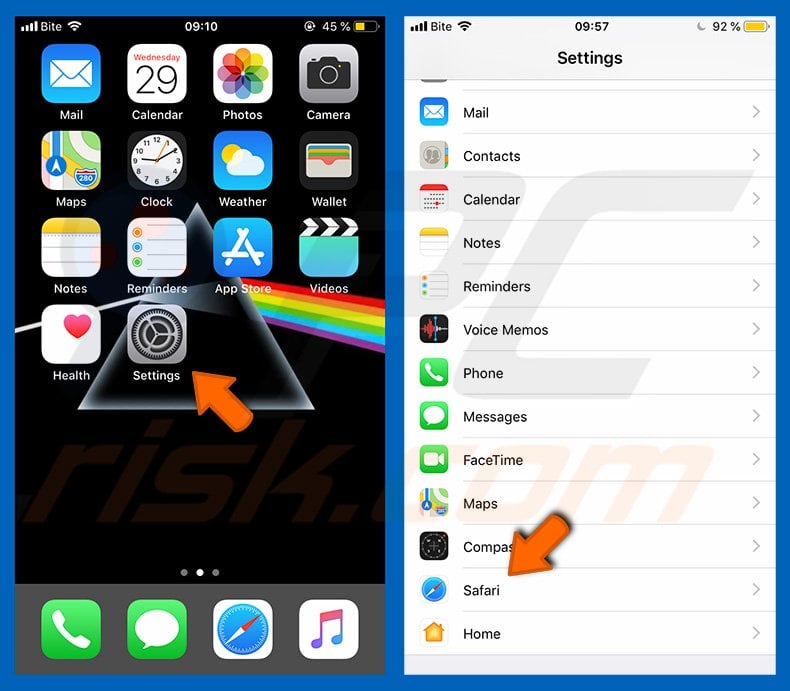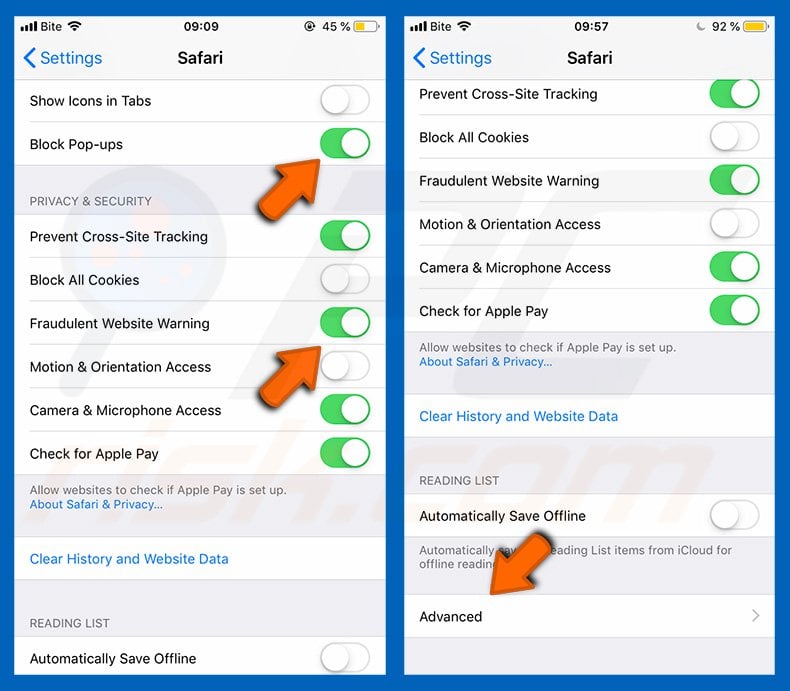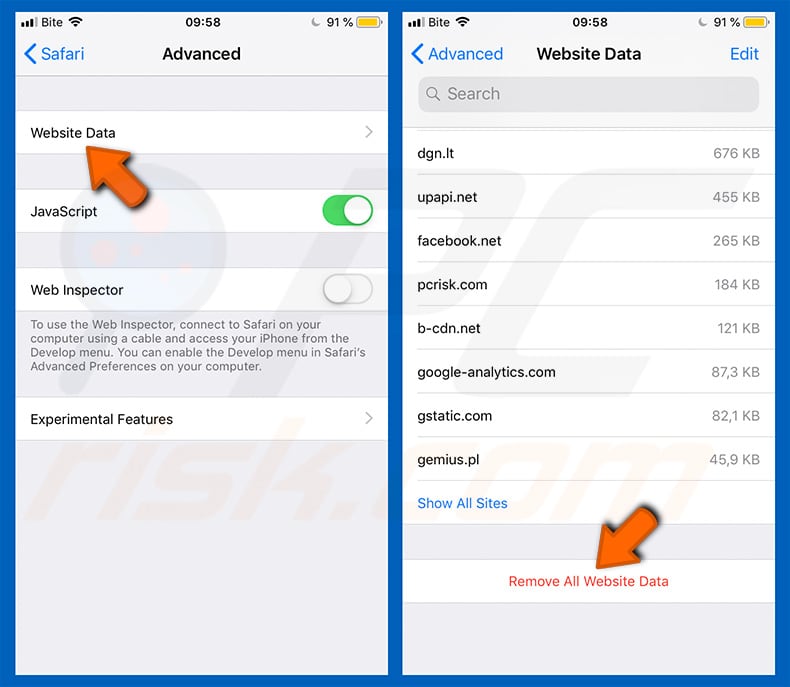Avoid getting scammed by the content hosted on adsafesafarifix.com website
Mac VirusAlso Known As: adsafesafarifix.com pop-up
Get free scan and check if your device is infected.
Remove it nowTo use full-featured product, you have to purchase a license for Combo Cleaner. Seven days free trial available. Combo Cleaner is owned and operated by RCS LT, the parent company of PCRisk.com.
What kind of page is adsafesafarifix[.]com?
Adsafesafarifix[.]com is an untrustworthy website promoting various scams. When we inspected this page, it ran "APPLE SECURITY BREACH" - but it might run other scams as well.
Users typically access deceptive webpages like adsafesafarifix[.]com inadvertently. Most enter them through mistyped URLs or redirects caused by sites using rogue advertising networks, intrusive advertisements, spam browser notifications, or installed adware.
![adsafesafarifix[.]com scam](/images/stories/screenshots202203/adsafesafarifix-com-scam-website-main.jpg)
Adsafesafarifix[.]com overview
The behavior of adsafesafarifix[.]com and similar pages (i.e., what they host/endorse) may depend on the visitor's IP address/ geolocation. When we entered this website, it promoted the "APPLE SECURITY BREACH" technical support scam.
This type of scam hinges on users being alarmed by fake virus/threat warnings and calling the fake helplines they provide. The scam in question, informs users that their data has been breached and the security of their iPhones was compromised. The scam also alleges that the attackers are transferring personal information and photos.
According to the scam, the nonexistent issues can be addressed by calling "Apple Technical Support". It must be emphasized that all these claims are false, nor is this scam in any way associated with Apple Inc.
Tech support scams aim to trick users into calling the scammers and allowing them remote access to their devices. From that point on the cyber criminals (under the guise of "technicians") can remove security tools, install fake anti-viruses and other unwanted/harmful software, extract private data, and infect the system with malware (e.g., trojans, ransomware, etc.).
Furthermore, tech support scammers usually ask for exorbitant sums for their "services" and favor difficult/impossible to trace methods of fund-transferring (e.g., cryptocurrencies, gift cards, pre-paid vouchers, cash hidden in packages, etc.). What is more, successfully scammed victims are often targeted repeatedly.
To summarize, regardless of what content adsafesafarifix[.]com promotes, through it - users can experience system infections, serious privacy issues, financial losses, and even identity theft.
| Name | adsafesafarifix.com pop-up |
| Threat Type | Phishing, Scam, Mac malware, Mac virus |
| Fake Claim | Data breach has occurred, Apple security has crashed, user must call the provided phone number. |
| Detection Names | N/A (VirusTotal) |
| Tech Support Scammer Phone Number | +1-800-794-5019 |
| Symptoms | Fake error messages, fake system warnings, pop-up errors, hoax computer scan. |
| Distribution methods | Deceptive pop-up ads, free software installers (bundling), fake Flash Player installers, torrent file downloads. |
| Damage | Internet browser tracking (potential privacy issues), display of unwanted ads, redirects to dubious websites, loss of private information, financial losses, etc. |
| Malware Removal (Windows) |
To eliminate possible malware infections, scan your computer with legitimate antivirus software. Our security researchers recommend using Combo Cleaner. Download Combo CleanerTo use full-featured product, you have to purchase a license for Combo Cleaner. 7 days free trial available. Combo Cleaner is owned and operated by RCS LT, the parent company of PCRisk.com. |
Online scams in general
The Internet is rife with misleading, deceptive, and malicious content. We have analyzed thousands of scam pages; vinkens[.]com, protectconnection[.]icu, socerapp.xyz, and blocker[.]digital are just some examples of those similar to adsafesafarifix[.]com.
While technical support scams targeting Apple product users (e.g., "Your MAC has been blocked due to suspicious activity!", "Error Code: #2c522hq8wwj791", "ZEUS VIRUS DETECTED !!!", etc.) are not quite as common as those employed against Windows users (e.g., "Microsoft Windows Virus Alert", "Alert! Windows-11 Can Not Update", "Your computer is disabled. Please call Microsoft.", etc.) - the dangers they pose are identical.
Additionally, the former are often targeted by other scams, such as threat warnings and missing/outdated software alerts (e.g., "Your iPhone Was Hacked", "Malware detected! iPhone need to be repaired", "We have detected a potential risk of unsecured connection", "Fake Flash Player Update", etc.). Although they differ from tech support scams - these schemes primarily seek to bait users into downloading/installing or purchasing untrustworthy and harmful software.
Due to how widespread scams are online, we strongly advise exercising caution when browsing.
How did I open a scam website?
Deceptive sites are typically accessed unintentionally. Mistyping a website's address (URL) can land the user on a scam page (or cause a redirect chain culminating in one).
Additionally, webpages that employ rogue advertising networks can force-open scam-promoting websites the moment they are accessed or cause redirects to them when the buttons, links, ads, or other hosted content is clicked.
Intrusive advertisements and spam browser notifications commonly promote deceptive pages. Furthermore, adware can display scam-pushing adverts or force-open such sites.
How to avoid visiting scam websites?
We advise against using sites that offer pirated content or other questionable services (e.g., Torrenting, illegal streaming/downloading, etc.) - since these websites are usually monetized through rogue advertising networks, which are infamous for promoting scams.
Additionally, if you enter a suspicious page, do not click "Allow", "Allow Notifications", or similar options to permit it to deliver browser notifications, as they too endorse deceptive content. Instead, ignore notification delivery or deny it (i.e., select "Block", "Block Notifications", etc.).
Adware can push online scams as well. Therefore, download only from official/verified sources and be vigilant when installing (i.e., read terms, choose "Custom/Advanced" settings, etc.).
Having a dependable anti-virus installed and updated is paramount to device/user safety. Security programs must be used to run regular system scans and to remove detected threats. If your computer is already infected, we recommend running a scan with Combo Cleaner Antivirus for Windows to automatically eliminate all threats.
Text presented in the scam promoted on adsafesafarifix[.]com website:
Warning! Security Data Breach! Apple Support TollFree +1-800+794-5019
Warning!!
APPLE SECURITY BREACH!!
IOS SECURITY CRASH!!
Transfering Your Personal Data and Pictures.
Call Apple Support (Toll-Free) +1-800-794-5019
Call +1-800-794-5019 immediately to connect with Apple Technical Support for installing the Protection Software.
Call +1-800-794-5019 immediately to connect with Apple Technical Support for installing the Protection Software.
More ways to shop: Visit an Apple Store.
Call +1-800-794-5019, or find a reseller.
To enable pop-up blocking, fraudulent website warnings, and remove web browsing data in mobile Apple devices, follow these steps:
First, go to "Settings", and then scroll down to find and tap "Safari".

Check if the "Block Pop-ups" and "Fraudulent Website Warning" toggles are enabled. If not, enable them immediately. Then, scroll down and tap "Advanced".

Tap "Website Data" and then "Remove All Website Data".

Instant automatic malware removal:
Manual threat removal might be a lengthy and complicated process that requires advanced IT skills. Combo Cleaner is a professional automatic malware removal tool that is recommended to get rid of malware. Download it by clicking the button below:
DOWNLOAD Combo CleanerBy downloading any software listed on this website you agree to our Privacy Policy and Terms of Use. To use full-featured product, you have to purchase a license for Combo Cleaner. 7 days free trial available. Combo Cleaner is owned and operated by RCS LT, the parent company of PCRisk.com.
Quick menu:
- What is "adsafesafarifix[.]com"?
- STEP 1. Remove PUA related files and folders from OSX.
- STEP 2. Remove rogue extensions from Safari.
- STEP 3. Remove rogue add-ons from Google Chrome.
- STEP 4. Remove potentially unwanted plug-ins from Mozilla Firefox.
Video showing how to remove adware and browser hijackers from a Mac computer:
Potentially unwanted applications removal:
Remove potentially unwanted applications from your "Applications" folder:

Click the Finder icon. In the Finder window, select "Applications". In the applications folder, look for "MPlayerX","NicePlayer", or other suspicious applications and drag them to the Trash. After removing the potentially unwanted application(s) that cause online ads, scan your Mac for any remaining unwanted components.
DOWNLOAD remover for malware infections
Combo Cleaner checks if your computer is infected with malware. To use full-featured product, you have to purchase a license for Combo Cleaner. 7 days free trial available. Combo Cleaner is owned and operated by RCS LT, the parent company of PCRisk.com.
Remove adware-related files and folders

Click the Finder icon, from the menu bar. Choose Go, and click Go to Folder...
 Check for adware generated files in the /Library/LaunchAgents/ folder:
Check for adware generated files in the /Library/LaunchAgents/ folder:

In the Go to Folder... bar, type: /Library/LaunchAgents/

In the "LaunchAgents" folder, look for any recently-added suspicious files and move them to the Trash. Examples of files generated by adware - "installmac.AppRemoval.plist", "myppes.download.plist", "mykotlerino.ltvbit.plist", "kuklorest.update.plist", etc. Adware commonly installs several files with the exact same string.
 Check for adware generated files in the ~/Library/Application Support/ folder:
Check for adware generated files in the ~/Library/Application Support/ folder:

In the Go to Folder... bar, type: ~/Library/Application Support/

In the "Application Support" folder, look for any recently-added suspicious folders. For example, "MplayerX" or "NicePlayer", and move these folders to the Trash.
 Check for adware generated files in the ~/Library/LaunchAgents/ folder:
Check for adware generated files in the ~/Library/LaunchAgents/ folder:

In the Go to Folder... bar, type: ~/Library/LaunchAgents/

In the "LaunchAgents" folder, look for any recently-added suspicious files and move them to the Trash. Examples of files generated by adware - "installmac.AppRemoval.plist", "myppes.download.plist", "mykotlerino.ltvbit.plist", "kuklorest.update.plist", etc. Adware commonly installs several files with the exact same string.
 Check for adware generated files in the /Library/LaunchDaemons/ folder:
Check for adware generated files in the /Library/LaunchDaemons/ folder:

In the "Go to Folder..." bar, type: /Library/LaunchDaemons/

In the "LaunchDaemons" folder, look for recently-added suspicious files. For example "com.aoudad.net-preferences.plist", "com.myppes.net-preferences.plist", "com.kuklorest.net-preferences.plist", "com.avickUpd.plist", etc., and move them to the Trash.
 Scan your Mac with Combo Cleaner:
Scan your Mac with Combo Cleaner:
If you have followed all the steps correctly, your Mac should be clean of infections. To ensure your system is not infected, run a scan with Combo Cleaner Antivirus. Download it HERE. After downloading the file, double click combocleaner.dmg installer. In the opened window, drag and drop the Combo Cleaner icon on top of the Applications icon. Now open your launchpad and click on the Combo Cleaner icon. Wait until Combo Cleaner updates its virus definition database and click the "Start Combo Scan" button.

Combo Cleaner will scan your Mac for malware infections. If the antivirus scan displays "no threats found" - this means that you can continue with the removal guide; otherwise, it's recommended to remove any found infections before continuing.

After removing files and folders generated by the adware, continue to remove rogue extensions from your Internet browsers.
Remove malicious extensions from Internet browsers
 Remove malicious Safari extensions:
Remove malicious Safari extensions:

Open the Safari browser, from the menu bar, select "Safari" and click "Preferences...".

In the preferences window, select "Extensions" and look for any recently-installed suspicious extensions. When located, click the "Uninstall" button next to it/them. Note that you can safely uninstall all extensions from your Safari browser - none are crucial for regular browser operation.
- If you continue to have problems with browser redirects and unwanted advertisements - Reset Safari.
 Remove malicious extensions from Google Chrome:
Remove malicious extensions from Google Chrome:

Click the Chrome menu icon ![]() (at the top right corner of Google Chrome), select "More Tools" and click "Extensions". Locate all recently-installed suspicious extensions, select these entries and click "Remove".
(at the top right corner of Google Chrome), select "More Tools" and click "Extensions". Locate all recently-installed suspicious extensions, select these entries and click "Remove".

- If you continue to have problems with browser redirects and unwanted advertisements - Reset Google Chrome.
 Remove malicious extensions from Mozilla Firefox:
Remove malicious extensions from Mozilla Firefox:

Click the Firefox menu ![]() (at the top right corner of the main window) and select "Add-ons and themes". Click "Extensions", in the opened window locate all recently-installed suspicious extensions, click on the three dots and then click "Remove".
(at the top right corner of the main window) and select "Add-ons and themes". Click "Extensions", in the opened window locate all recently-installed suspicious extensions, click on the three dots and then click "Remove".

- If you continue to have problems with browser redirects and unwanted advertisements - Reset Mozilla Firefox.
Frequently Asked Questions (FAQ)
What is a pop-up scam?
Pop-up scams are deceptive messages designed to bait users into performing certain actions, e.g., calling fake helplines, allowing remote access to their devices, making monetary transactions, revealing sensitive information, installing (likely fake or malicious) software, and so on.
What is the purpose of a pop-up scam?
Like all scams, those that employ pop-ups are created to generate revenue for their designers. Scammers can profit through deceptively obtained funds, abuse or sale of private data, application promotion, malware proliferation, and so forth.
Why do I encounter fake pop-ups?
Pop-up scams are promoted on dubious webpages, which are rarely accessed intentionally. Most users enter them via redirects caused by intrusive ads, spam browser notifications, pages using rogue advertising networks, mistyped URLs, or installed adware.
I cannot exit a scam page, how do I close it?
If you cannot exit a scam page - end the browser's process. Upon reopening it, do not restore the previous browsing session since that will also open the deceptive website.
I have allowed cyber criminals to remotely access my computer, what should I do?
If you have allowed cyber criminals to remotely access your device, immediately disconnect it from the Internet. Secondly, uninstall the remote access software the criminals had used (as they may not need your consent to re-access it). Lastly, perform a full system scan, and if any threats are detected - remove them using an anti-virus.
I have provided my personal information when tricked by a pop-up scam, what should I do?
If you provided account credentials - change the passwords of all potentially exposed accounts and inform their official support without delay. And if you disclosed other private information (e.g., ID card details, credit card numbers, etc.) - contact the relevant authorities without delay.
Will Combo Cleaner protect me from pop-up scams and the malware they proliferate?
Combo Cleaner can scan the websites you visit and alert you if they are found to be deceptive/malicious. Furthermore, it can restrict access to such pages. Combo Cleaner is also capable of scanning devices and eliminating most of the known malware infections. However, running a complete system scan is essential, as high-end malicious programs usually hide deep within the system.
Share:

Tomas Meskauskas
Expert security researcher, professional malware analyst
I am passionate about computer security and technology. I have an experience of over 10 years working in various companies related to computer technical issue solving and Internet security. I have been working as an author and editor for pcrisk.com since 2010. Follow me on Twitter and LinkedIn to stay informed about the latest online security threats.
PCrisk security portal is brought by a company RCS LT.
Joined forces of security researchers help educate computer users about the latest online security threats. More information about the company RCS LT.
Our malware removal guides are free. However, if you want to support us you can send us a donation.
DonatePCrisk security portal is brought by a company RCS LT.
Joined forces of security researchers help educate computer users about the latest online security threats. More information about the company RCS LT.
Our malware removal guides are free. However, if you want to support us you can send us a donation.
Donate
▼ Show Discussion